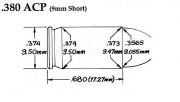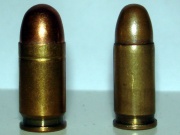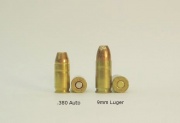.380 ACP
| .380 ACP | |||||||||||||
|---|---|---|---|---|---|---|---|---|---|---|---|---|---|
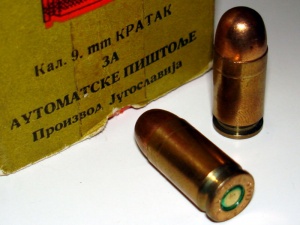
| |||||||||||||
| Yugoslavian "9 mm Kratak" (9 mm Short) cartridges, FMJ. | |||||||||||||
| Type | Pistol | ||||||||||||
| Country of Origin | USA | ||||||||||||
| Specifications | |||||||||||||
| Case Type | Rimless, straight | ||||||||||||
| Bullet Ø | .355 in (9.0 mm) | ||||||||||||
| Neck Ø | .373 in (9.5 mm) | ||||||||||||
| Shoulder Ø | n/a | ||||||||||||
| Base Ø | .374 in (9.5 mm) | ||||||||||||
| Rim Ø | .374 in (9.5 mm) | ||||||||||||
| Rim Thickness | .045 in (1.1 mm) | ||||||||||||
| Case Length | .680 in (17.3 mm) | ||||||||||||
| Full Length | .984 in (25.0 mm) | ||||||||||||
| Production & Service | |||||||||||||
| Designer | John Browning | ||||||||||||
| Design Date | 1906/07 | ||||||||||||
| Manufacturer | Colt Manufacturing Company | ||||||||||||
| Production Dates | 1908-present | ||||||||||||
| Ballistic Performance Sampling | |||||||||||||
| |||||||||||||
The .380 ACP (Automatic Colt Pistol) (also referred to as the "9 mm Short", "9 mm Browning", "9 mm Kurz", "9 mm Corto" or "9x17mm") pistol cartridge is a rimless, straight-walled pistol cartridge developed by firearms designer John Browning. It was introduced in 1908 by Colt, and has been a popular self-defense cartridge ever since.
Contents |
[edit] Design
The .380 ACP cartridge was designed for early blowback pistols which lacked a barrel locking mechanism. The locking mechanism that is found on most other pistols is not necessary for the .380 because of the round's low breech pressure when fired; the guide spring is enough to buffer the energy displaced to the slide. This simplifies manufacture of pistols chambered for such a round, generally thereby lowering the cost. It also permits the barrel to be permanently fixed to the frame during firing, which promotes accuracy. There have, however, been a number of locked breech pistols chambered in .380 ACP. There have also been some diminutive submachine guns, such as the Ingram MAC-11.[2]The cartridge is ballistically similar to the slightly hotter 9x18mm Makarov service pistol cartridge developed in the Soviet Union.[3]
[edit] Performance
The .380 ACP is compact and light, but short ranged and having marginal stopping power.[4] Even so, it remains a popular self-defense cartridge for shooters who want a lightweight pistol with manageable recoil. It is slightly less powerful than a standard-pressure .38 Special and uses 9 mm(.355 in) bullets. The heaviest bullet that can be safely loaded into the .380 ACP is 115 grains (7.5 g), though the standard has long been 85, 90 or 95 grains (5.5, 5.8 or 6.2 g). Many consider the .380 ACP to be the minimum cartridge suitable for self defense, while others draw the line at the slightly more powerful .38 Special or at the less powerful .32 ACP. The .380 has had somewhat of a recent upsurge in popularity due to some very compact and lightweight pistols chambered for it.
There are numerous cartridges similar to the .380 ACP such as semi-rimmed .38 ACP, rebated rim 9mm Nickl,[5] the 9mm Ultra, and 9mm Makarov.
[edit] Synonyms
- 9x17mm Short
- 9 mm Kurz
- 9 mm Corto
- 9 mm Court
- 9 mm Short
- 9 mm Kratak
- 9 mm Browning Short
- 9 mm Scurt
[edit] See also
[edit] References
- ↑ Federal Cartridge Ballistics
- ↑ Ingram MAC Model 10 / M10 and Model 11 / M11 submachine guns (USA)
- ↑ A Comparison of 9x18 mm Makarov, .380 ACP, and .38 Special (2-inch/50-millimetre barrel)
- ↑ .380ACP Terminal Ballistics
- ↑ 9mm Nickl identification
[edit] External links
| This article is part of a series on the works of John Moses Browning | ||
|---|---|---|
| Semi-automatic pistols | FN M1900 · Colt M1900 · Colt M1902 · FN Model 1903 · M1903 Pocket Hammer · M1903 Pocket Hammerless · M1908 Vest Pocket · FN Model 1910 · M1911 · Colt Woodsman · Baby Browning · Hi-Power | 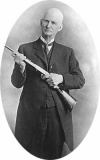 |
| Rifles | Winchester Model 1885 · Winchester Model 1886 · Winchester 1892 · Winchester Model 1894 · Winchester Model 1895 · Remington Model 8 · Remington Model 24 · FN Trombone | |
| Shotguns | Winchester Model 1887 · Winchester Model 1897 · Browning Auto-5/Remington Model 11 · Remington Model 17 · Savage Model 520 · Browning Superposed · Ithaca 37 | |
| Machine guns | Colt-Browning M1895 · Browning M1917 · Browning Automatic Rifle · Browning M1919 · M2 Machine Gun | |
| Cartridges | .25 ACP · .32 ACP · .38 ACP · .380 ACP · .45 ACP · .50 BMG | |
